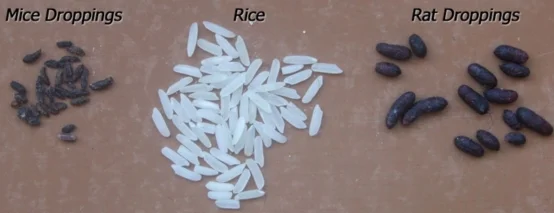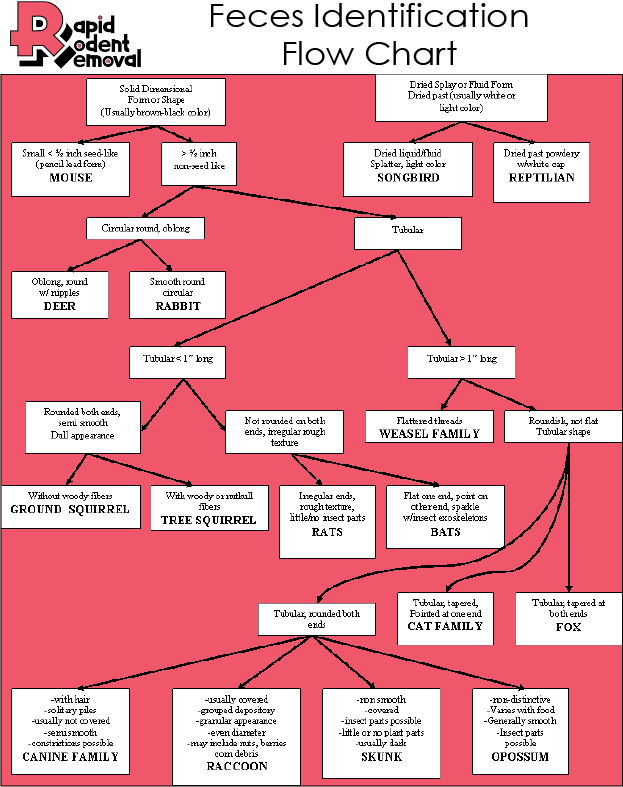MOUSE POOP
What Does mouse poop look like ?
Pictures and Descriptions of mouse Poop, mouse Feces, mouse Droppings
Mouse poop, also known as mouse/mice droppings or mice/mouse feces, are small and dark brown or black in color. They have a cylindrical shape and are granular in texture. They are typically about the size of a grain of rice and have pointed ends. The droppings are shiny and black, about 1/4 inch long. They are often found in clusters and may look similar to small pellets. They are often found near food sources or in areas where mice are active. It is important to be able to identify mouse droppings as they can indicate the presence of mice in a home or building. If you notice mouse droppings, it is important to take action to remove the mice and clean up the droppings to prevent the spread of disease.
Mouse droppings and rat droppings are both small and cylindrical in shape, but they have some key differences. Mouse droppings are typically about the size of a grain of rice and have pointed ends, while rat droppings are larger and more oblong in shape. Mouse droppings are dark brown or black and are granular in texture, while rat droppings are dark brown or black and are smooth and shiny. Rat droppings are also much larger than mouse droppings, about 3/4 to 1 inch long. Additionally, mouse droppings are often found in clusters, while rat droppings are found singly or in small groups. It is important to be able to tell the difference between mouse droppings and rat droppings as it can indicate the type of rodent present in a home or building.
There's nothing quite as unsettling as stumbling upon rat poop in your living space. It's not just a matter of grossness; rat droppings can pose serious health risks. But don't fret! We've got you covered with a step-by-step guide on what to do if you find rat poop in your home.
How to Identify Mouse Poop ?
mouse poop, mice droppings, mice feces, mice poop, mouse droppings, mouse feces,
Mouse poop is small, about the size of a grain of rice, and is dark in color.
Squirrel poop is larger, about the size of a bean, and is often twisted or curved. The shape and size of the droppings can help to distinguish between the two. Additionally, mouse droppings are often found in small clusters, while squirrel droppings are usually found individually.
We at rapid Rodent Removal want you to know It’s not hard to identify the rodent’s poop when your property suffers from a rat infestation - you may notice tiny dark pellets of poop scattered everywhere. But, how do you know if these faeces belong to a rat and not a mouse? There’s a simple way to identify them:
Mouse Poop, is much smaller than most feces, think small like rice
what does rat poop look like ?
what does squirrel poop look like ?
what does raccoon poop look like ?
what does opossum poop look like ?
Mouse Poop
How to Safely Clean Mouse poop ?
Open the doors and windows. Ventilate the room for at least 30 minutes before you begin cleaning.
Wear protective gear. Use rubber gloves, so you don't touch the waste directly; a face mask, so you don't inhale the dust (as we said, diseases can be transmitted by inhaling polluted dust); even consider wearing protective goggles, so contaminated dust doesn’t get into your eyes.
Spray with a 10% chlorine bleach solution. Mix 360 millilitres of chlorine bleach with 5 litres of hot water and spray the droppings with the solution. Don't sweep or vacuum, as this will release pathogens into the air and/or trap said pathogens on your broom or in your vacuum cleaner.
Pick up the droppings with a paper towel. Then, place them in a plastic bag with a sealer. Put the paper towel in a plastic bag with a sealer, as well. Dispose of the plastic bags outside of your home.
Wipe all floors and surfaces with disinfectant. Use the same solution of 10% chlorine bleach. Use a paper towel to dry.
Wash your hands. Use hot water and a disinfectant to clean your hands. Don't forget to scrub under your nails and around your wrists
Mouse Poop pictures, What Does it Look like ?
Squirrel droppings closely resemble rat feces. Both pests’ poop is dark brown and smooth, but squirrels leave larger, barrel-shaped pellets behind while rats produce small, oblong-shaped droppings with tapered ends. Squirrel feces often appear under trees, around bird feeders, and inside crawl spaces in homes or businesses. Mice feces is small like rice
rat poop vs Squirrel poop vs mouse poop
mouse poop flow chart
Mouse Droppings
Mouse Droppings : How to Safely Clean ?
Open the doors and windows. Ventilate the room for at least 30 minutes before you begin cleaning.
Wear protective gear. Use rubber gloves, so you don't touch the waste directly; a face mask, so you don't inhale the dust (as we said, diseases can be transmitted by inhaling polluted dust); even consider wearing protective goggles, so contaminated dust doesn’t get into your eyes.
Spray with a 10% chlorine bleach solution. Mix 360 millilitres of chlorine bleach with 5 litres of hot water and spray the droppings with the solution. Don't sweep or vacuum, as this will release pathogens into the air and/or trap said pathogens on your broom or in your vacuum cleaner.
Pick up the droppings with a paper towel. Then, place them in a plastic bag with a sealer. Put the paper towel in a plastic bag with a sealer, as well. Dispose of the plastic bags outside of your home.
Wipe all floors and surfaces with disinfectant. Use the same solution of 10% chlorine bleach. Use a paper towel to dry.
Wash your hands. Use hot water and a disinfectant to clean your hands. Don't forget to scrub under your nails and around your wrists
mice vs mouse
"Mice" is the plural form of "mouse," which refers to a small rodent typically found in homes and other buildings. A single small rodent is referred to as a "mouse."
Prevention is Better than Cure: Keeping mice at Bay
A. Seal Up Entry Points including all Cracks and Holes gaps in Doors and Windows and maintain Proper Food Storage, feed your pets inside, then set traps
Frequently Asked Questions about mouse poop, mouse droppings or mouse feces
How can I tell if the MOUSE droppings are old or new?
To determine whether mouse droppings are old or new, you can look at their color and texture.Fresh rat droppings are typically dark brown and moist, while older droppings can become dry and brittle, and may appear lighter in color.
You can also try pressing on the droppings with a tool or your finger. If they are soft and pliable, they are likely fresh. If they crumble or break apart easily, they are probably old.
It's important to note that mouse droppings can carry disease, so it's recommended to wear gloves and a mask when handling them, and to thoroughly disinfect the area afterwards.
What should I do if I find mouse poop in my kitchen or pantry?
Take preventative measures: To prevent future infestations, make sure to store food in airtight containers, keep your kitchen and pantry clean and free of debris, and regularly inspect for signs of rat activity.How long does it take for a professional exterminator to eliminate a mouse infestation?
Sometimes it can be fixed overnight with mice trapping, but it generally takes 2-6 weeks
Discovering rat poop in your home can be both distressing and potentially dangerous. But now you know what to do if you find rat poop: identify the droppings, clean and disinfect the area, and take steps to prevent future infestations. Don't hesitate to call in a professional exterminator if the problem becomes too big to handle on your own. Remember, a rat-free home is a healthy and happy home.
In an attempt to remind customers that Rapid Rodent Removal are also roofers, we have also made a table of contents with all of our information about rats , mouse , squirrels and Roofing , Roof Repair , Roof Replacement (articles & blog) stemming from to all about Rat poop , Mouse poop , Squirrel poop or Raccoon poop in Your Home & or Rats in Attic, to Roofing Contractors to Rodent Control.





